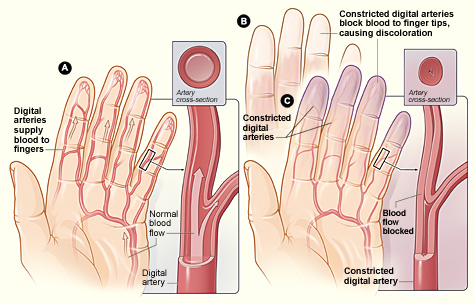Playlist
Show Playlist
Hide Playlist
Raynaud's Disease: Symptoms, Diagnosis and Therapy
-
Slides 02 VascularMedicine advanced.pdf
-
Download Lecture Overview
00:00 So the symptoms of Raynaud's occur when the patient handles something that's cold—for example, a cold bottle of beer or soda. Then, ischemia develops due to the vasospasm. The skin turns pale or white on the fingertips and becomes cold and numb. Actually, after a while, because of decreased blood flow, the fingertips may even become blue, so-called cyanotic—because the blood there has lost its oxygen. And then when the fingers are warmed, there's hyperemia, or increased blood flow, and the fingertips become red and often painful when the blood flow returns. And the fingers may even swell and throb, and you may actually even have trouble feeling the tips of the fingertips. How is the diagnosis made, and what is the therapy? Well, the diagnosis: First of all, you have to distinguish primary from secondary Raynaud's. Patients undergo an extensive evaluation looking for arthritis or vasculitis, looking for rheumatoid arthritis, lupus, scleroderma—a whole variety of autoimmune diseases. When the patient is found not to have those, then they either have secondary Raynaud's—because they're very sensitive to cold but they don't have any systemic disease—or they have the primary illness, where even with just moderate exposure to cold, they may develop the Raynaud's. 01:35 And in that case, it's often an inherited thing. The family history will tell you, "Oh, yes, my mother and grandmother had the same thing." But in the case of the disease, once people are in a warm climate, usually it's well controlled. 01:50 Treatment: Of course, abstinence from smoking (just like with Buerger's disease, smoking can make the spasm worse) and avoidance of cold. And as I said, many of these people move to warmer climates. Vasodilating drugs can be helpful: calcium channel blockers and prazosin. Sometimes, particularly in the milder forms of secondary, patients may be able to stay in a cold climate, wearing warm gloves and taking vasodilators. And a more aggressive approach is actually interrupting the sympathetic nerves. But these days, we usually don't do that. We're usually able to control it with vasodilator drugs and avoidance of cold.
About the Lecture
The lecture Raynaud's Disease: Symptoms, Diagnosis and Therapy by Joseph Alpert, MD is from the course Arterial Diseases.
Included Quiz Questions
Why do fingertips become pale in Raynaud's phenomenon?
- Vasospasm
- Vasodilation
- Venodilation
- Hyperemia
- Edema
Customer reviews
5,0 of 5 stars
| 5 Stars |
|
5 |
| 4 Stars |
|
0 |
| 3 Stars |
|
0 |
| 2 Stars |
|
0 |
| 1 Star |
|
0 |




